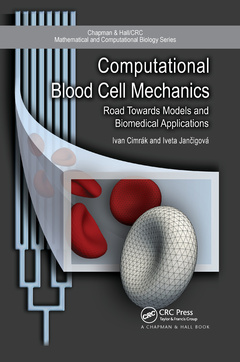Description
Computational Blood Cell Mechanics
Road Towards Models and Biomedical Applications
Chapman & Hall/CRC Computational Biology Series
Language: English
Subjects for Computational Blood Cell Mechanics:
Keywords
LBM; Circulating Tumor Cells; cell-cell nteractions; Area Expansion Modulus; blood damage index; Rbc; cell modelling; Fluid Structure Interaction; Microfluidic Device; RBC; Cell Cell Interaction; VAD; Triangle ABC; Ventricular Assist Devices; Spring Network; Mesh Points; Simulation Box; Average Edge Length; Friction Coefficient; Volume Forces; Simulation Script; Cylindrical Obstacle; RBC Membrane; Rare Cell; DPD Model; IBM; BRCA Gene Mutation; Artificial Immune System
Publication date: 09-2020
· 15.6x23.4 cm · Paperback
Publication date: 09-2018
· 15.6x23.4 cm · Hardback
Description
/li>Contents
/li>Biography
/li>
Simulating blood cells for biomedical applications is a challenging goal. Whether you want to investigate blood flow behavior on the cell scale, or use a blood cell model for fast computational prototyping in microfluidics, Computational Blood Cell Mechanics will help you get started, and show you the path forward.
The text presents a step-by-step approach to cell model building that can be adopted when developing and validating models for biomedical applications, such as filtering and sorting cells, or examining flow and deformations of individual cells under various conditions. It starts with basic building-blocks that, together, model the red blood cell membrane according to its physical properties, before moving on to discuss several issues that may pose problems along the way, and finally leads to suggestions on how to set up computational experiments.
More details available at www.compbloodcell.eu
1 Introduction
2 Illustrative simulation example
3 Cell model
4 Model vs. bioreality
5 Practical issues
6 Applications
7 Ideas for extension
8 Dreaming up the future
Appendix A: Force- and torque-free bending modulus
Appendix B: Comparison of area interactions to other approaches
Appendix C: Force- and torque-free volume modulus
Appendix D: Calculus of spring network deformations
Appendix E: Complete example script
Appendix F: Simulation setup
Ivan Cimrák is an associate professor at University of Žilina, Slovakia and the Head of the Cell-in-Fluid Research Group.
Iveta Jančigová is a research assistant at University of Žilina, Slovakia and member of the Cell-in-Fluid Research Group.
Both authors are contributors to the open-source project ESPResSo.



